From Godzilla to King Kong, the fascination for the rampaging monsters never ends
The latest cinematic showdown between the two creatures along with the new Ghostbusters release sees iconic cities being demolished again, fueling a genre that has refined its visual spectacle but has lost its narrative quality
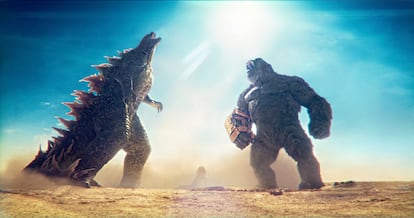

Every time a Godzilla movie is premiered, we hear one comment repeatedly: we don’t want to see humans talking about government conspiracies and family problems, we want to see monsters bashing each other and destroying cities. If viewers had a remote control, some would fast-forward through Millie Bobby Brown or Bryan Cranston discussing internal conflicts as if they were performing in a Shakespeare play at the end of the world. Indeed, in the three-minute trailer for Godzilla x Kong: The New Empire, people occupied barely 20 seconds. It showed the giant gorilla carrying a huge axe and riding on the back of the kaiju (a giant monster in Japan) to fight together. The movie’s viewpoint belongs to the monsters. They certainly know what their audience wants.
If moviegoers pack an IMAX (image maximum) cinema, it will be to see the monster spray violet rays, buildings collapsing and bridges under siege. Even if they are more familiar with San Francisco’s Golden Gate Bridge crumbling in ruins rather than standing upright. Charlton Heston endured the destruction of such an iconic landmark at the end of Planet of the Apes, but the chaos in recognizable cities like New York makes for a warm and happy place for the audience, as opposed to the reality of Ukraine and Gaza. That grandiloquence where everything tumbles down is one more reason not to watch the film at home. The fake apocalypse with computerized monsters and ever greater visual effects guarantees a collective experience in cinemas. This is paramount for studios struggling to get their blockbusters onto high-end screens, which are more expensive and therefore inflate box-office figures.
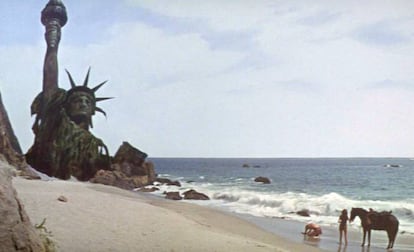
However, destruction is nothing new in Hollywood. “There were catastrophe films in silent cinema. It had a boom in the thirties, its heyday in the seventies and a resurgence in the nineties. Nowadays, they never stop,” remembers Sintu Amat, author of the book Disaster Movies. “Whether there are wars or not, we’ll always be attracted to destruction and chaos. Although we may be convinced that it won’t happen in the near future, we like to fantasize about visualizing it and enjoy it. We have a dark side when it comes to catastrophic issues. These are stories that put normal characters in extreme situations with which we can identify ourselves,” he adds. Sigmund Freud called repetition compulsion the impulse to replicate painful situations that drive us to control our imagination and thereby cope with our fears, while finding comfort.
Amat points to classics such as San Francisco (1936), Green Dolphin Street (1947), The Naked Jungle (1954) and The Devil at 4 O’Clock (1961), and he explains that their “plots, characters and brilliant dialogues” stand out. “Their catastrophes helped resolve the plots and determine the fate of the main characters.” He points out that special effects have improved and technology has made them more striking and easier to produce, although this may be to the detriment of other qualities.
This selling-point of spectacularity has a prosaic aspect in human psychology and is also an economic driver. In 2023, IMAX cinemas broke records by grossing more than $1 billion, with all-time high revenues in 54 countries. Their ticket sales were up 24.4% largely because of Oppenheimer, which is about the creation of the atomic bomb that spawned Godzilla as a nuclear metaphor in 1954. The much more introspective Godzilla Minus One was the hottest IMAX release in Japanese movie history.
Everyone in Hollywood is battling for these cinemas, including Tom Cruise, who was frustrated that Mission: Impossible was unable to take advantage of so many giant screens because of Oppenheimer. The CEO of IMAX had to step in to mediate: “I feel sad, but Nolan has a special place in IMAX’s heart.” In January, Warner, in an effort to coordinate all its pieces, moved the battle between King Kong and Godzilla (filmed using their technology) two weeks earlier to take over from Dune: Part Two and avoid having to share IMAX theaters with Civil War, Alex Garland’s (Ex-Machina) political post-apocalypse, whose poster shows the golden flame of the Statue of Liberty turned into a bunker amidst the destruction.
The demolition of an architectural symbol is an established cliché. The creators of The Towering Inferno (1974) and Independence Day (1996), which featured one of the most famous shots of the White House, obliterated by a laser from space, were well aware of this notion. Two years later, the film’s director, Roland Emmerich, shot Godzilla. They also had this in mind when a huge octopus scaled the Golden Gate Bridge in It Came from Beneath the Sea (1955) and when Michael Bay, an expert in destruction, devastated New York’s Grand Central in Armageddon (1999). This time, Kong and Godzilla adopt Napoleon’s legacy and attempt to conquer the pyramids of Egypt, just as the film Team America: World Police predicted in its parody of America’s passion for destroying movie icons. Along the way, they stamp through Cadiz and Gibraltar without a care in the world.
Cinemas are also still showing Ghostbusters: Frozen Empire, a saga that echoes the same glacial theme and opens the doors of the Empire State Building to its monsters as it did in 1984, although the Marshmallow Man did not cause quite as much terror. Almost as little as Sharknado, which was the delight of the lowbrow cinema in six TV movies. On the positive side, from the golden age of catastrophes, Sintu Amat highlights Earthquake (1974) and The Poseidon Adventure (1972), as well as Dante’s Peak (1997), the Norwegian film The Wave (2015) and Contagion (2011), which predated Covid-19.
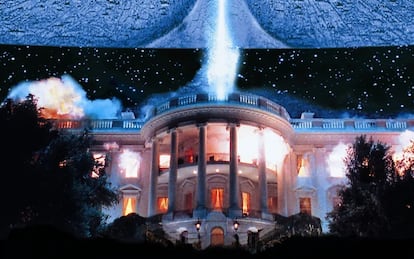
In an international context, some directors have made the most of the opportunity to stamp their style on the genre of raging monsters and destruction. Guillermo del Toro pitted robots against monsters in Pacific Rim; Nacho Vigalondo spun it into a toxic, city-destroying love story in Colossal; Marc Forster besieged capital cities with zombies in World War Z (David Fincher wanted to make the sequel but it never took off), and Bong Jon-hoo created one of the iconic works of the modern kaiju genre in The Host. Some succeeded in making humans interesting as well, like Shin Godzilla masterfully did, by modernizing truisms in a bureaucratic reinvention that had as much of The West Wing as of kaiju. Although it was inspired by the Fukushima disaster, today it has another interpretation after seeing how governments have dealt with the Covid-19 pandemic. Sometimes unreality is best grasped through exaggeration.
Even if audiences don’t want to see humans, the Godzilla/Kong Monsterverse has brought together John Goodman, Brie Larson, Tom Hiddleston, Kurt Russell, Dan Stevens and Rebecca Hall in its four movies and two series. And Hollywood’s greatest sagas keep calling the red phone when faced with monkey and amphibian assaults. In May, Kingdom of the Planet of the Apes will be staging its tenth movie battle. The Jurassic Park franchise will now be heading to the city with Jurassic City, where the dinosaurs attempt to bring something new to a disaster we’ve seen hundreds of times before. The meteorites of Greenland and the tornadoes of Twisters will also be back.
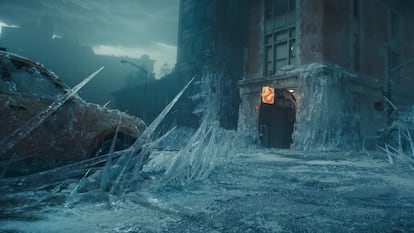
When climate change and wars push us closer to destruction, there is some comfort in non-reality. “We’re all concerned about the future of the planet and the human species,” concludes Amat. If Godzilla and Kong fail to deliver on their tale of unity in the face of phenomena to our true battles, it will be the moment to duck and replicate Charlton Heston by shouting out: “You blew it up! Ah, damn you! God damn you all to hell!”
Sign up for our weekly newsletter to get more English-language news coverage from EL PAÍS USA Edition
Tu suscripción se está usando en otro dispositivo
¿Quieres añadir otro usuario a tu suscripción?
Si continúas leyendo en este dispositivo, no se podrá leer en el otro.
FlechaTu suscripción se está usando en otro dispositivo y solo puedes acceder a EL PAÍS desde un dispositivo a la vez.
Si quieres compartir tu cuenta, cambia tu suscripción a la modalidad Premium, así podrás añadir otro usuario. Cada uno accederá con su propia cuenta de email, lo que os permitirá personalizar vuestra experiencia en EL PAÍS.
¿Tienes una suscripción de empresa? Accede aquí para contratar más cuentas.
En el caso de no saber quién está usando tu cuenta, te recomendamos cambiar tu contraseña aquí.
Si decides continuar compartiendo tu cuenta, este mensaje se mostrará en tu dispositivo y en el de la otra persona que está usando tu cuenta de forma indefinida, afectando a tu experiencia de lectura. Puedes consultar aquí los términos y condiciones de la suscripción digital.
More information
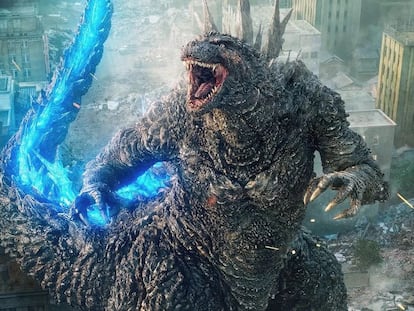
Godzilla is still king
Archived In
Últimas noticias
Trump claims peace in Ukraine is near, but Moscow suggests otherwise
A survivor’s account of the Interoceanic Train accident: ‘We were scared because of the speed on the curve’
The Interoceanic Train, the Mexican alternative to the Panama Canal
What is known about the Interoceanic Train derailment in Oaxaca
Most viewed
- Oona Chaplin: ‘I told James Cameron that I was living in a treehouse and starting a permaculture project with a friend’
- Reinhard Genzel, Nobel laureate in physics: ‘One-minute videos will never give you the truth’
- Why the price of coffee has skyrocketed: from Brazilian plantations to specialty coffee houses
- Pablo Escobar’s hippos: A serious environmental problem, 40 years on
- Chevy Chase, the beloved comedian who was a monster off camera: ‘Not everyone hated him, just the people who’ve worked with him’









































